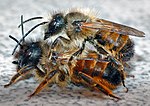Search results
The page "Solitary+Insects" does not exist. You can create a draft and submit it for review or request that a redirect be created, but consider checking the search results below to see whether the topic is already covered.
- Wasp (category Insects in culture)the nests of other wasps. Many of the solitary wasps are parasitoidal, meaning they lay eggs on or in other insects (any life stage from egg to adult) and...62 KB (6,767 words) - 02:02, 1 April 2024
- Sociality (redirect from Solitary but social)Behavior in Insects and Arachnids. Cambridge: Cambridge University Press. Tallamy, D.W.; Wood, T.K. 1986. "Convergence patterns in subsocial insects". Ann Rev...29 KB (3,103 words) - 13:13, 17 April 2024
- of insects. Their purposes include hosting pollinators. Many insect hotels are used as nest sites by insects including solitary bees and solitary wasps...16 KB (2,019 words) - 10:35, 5 April 2024
- animal species. The insect nervous system consists of a brain and a ventral nerve cord. Most insects reproduce by laying eggs. Insects breathe air through...134 KB (12,781 words) - 07:12, 12 May 2024
- Bee (redirect from Solitary bee)sweat bees – are solitary. Bees are found on every continent except Antarctica, in every habitat on the planet that contains insect-pollinated flowering...117 KB (12,159 words) - 09:21, 18 May 2024
- Eusociality (redirect from Social Insects)insect orders, including hymenopterans, termites, thrips, aphids, and beetles. The order Hymenoptera contains the largest group of eusocial insects,...65 KB (7,180 words) - 13:23, 18 May 2024
- Schmidt sting pain index (category Insect bites and stings)Hymenoptera that were primarily solitary, the pain alone would allow them the chance to escape. Furthermore, solitary insects do not provide a high energy...14 KB (1,739 words) - 16:32, 7 May 2024
- Australian hornet (category Insects described in 1775)and shrubs, before sealing the captured insects inside the nest's cells. The larvae then feed upon these insects, before emerging. "Abispa ephippium (Fabricius...3 KB (248 words) - 02:15, 13 September 2023
- honey before taking it back to the nest. Australian bees are mostly solitary insects. A female bee will build a nest with the aid of "workers". Native Australian...7 KB (633 words) - 02:25, 18 May 2024
- Ant (category Insects in culture)in comparison to the populations of other insects, representing only about 1% of fossil evidence of insects in the era. Ants became dominant after adaptive...149 KB (16,685 words) - 08:48, 9 May 2024
- Patanga succincta (category Insects described in 1763)is a species of locust found in India and southeast Asia. Usually a solitary insect, only in India has it has exhibited swarming behaviour. The last plague...6 KB (821 words) - 05:16, 25 March 2022
- orchard bees, squash bees, and solitary bees. Where the same plants have non-bee pollinators such as birds or other insects like flies, these are also indicated...18 KB (384 words) - 17:55, 29 December 2023
- African migratory locust (category Insects described in 1849)of the insects, further plagues occurred in the last two decades of the 20th century. The African migratory locust has two phases, a solitary one, where...10 KB (1,328 words) - 13:11, 8 August 2023
- Locust (redirect from Locust (insect))grasshoppers in the family Acrididae that have a swarming phase. These insects are usually solitary, but under certain circumstances they become more abundant and...54 KB (5,624 words) - 15:40, 7 May 2024
- Hunting wasp (redirect from Solitary wasp)of their larvae in that they capture prey, usually insects, to feed their larvae. Whether solitary or social, most species construct some form of protection...11 KB (1,425 words) - 14:39, 13 April 2024
- Locusta migratoria manilensis (category Insects described in 1835)It can exist in two phases, solitary and gregarious. The solitary adults are either green or brown, but as the insects become more crowded together,...8 KB (1,045 words) - 14:39, 8 September 2021
- species preferentially use hollow stems or holes in wood made by wood-boring insects. Species of the genus include the orchard mason bee O. lignaria, the blueberry...14 KB (1,639 words) - 01:20, 24 August 2023
- The solitary sandpiper (Tringa solitaria) is a small shorebird. The genus name Tringa is the Neo-Latin name given to the green sandpiper by Aldrovandus...6 KB (638 words) - 02:33, 17 January 2024
- Colony (biology) (redirect from Colonial insect)the context of development, may be composed of two or more unitary (or solitary) organisms or be modular organisms. Unitary organisms have determinate...16 KB (1,851 words) - 21:53, 4 February 2024
- Ichneumonoidea (category Insects in culture)Jurassic. Ichneumonoids are solitary insects, and the vast majority are parasitoids; the larvae feed on or in another insect until it finally dies. Most...9 KB (903 words) - 03:13, 21 January 2024
- May 1873 (1873) Instinct in Insects I by Georges Pouchet 583063Popular Science Monthly Volume 3 May 1873 — Instinct in Insects I1873Georges Pouchet Layout
- most livestock... insects are very efficient at converting feed into protein. Insects can be fed on organic waste streams. ...Insect harvesting/rearing
- including insect bites and anaphylactic shock. Tell how insects are different from all other animals. Show the differences between insects, centipedes


















